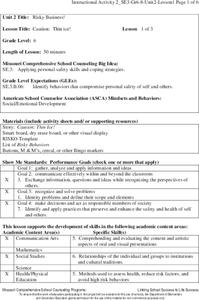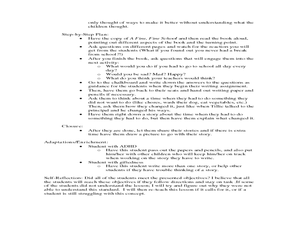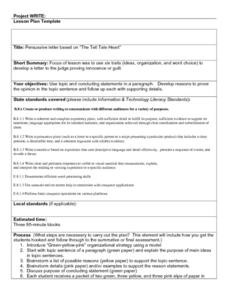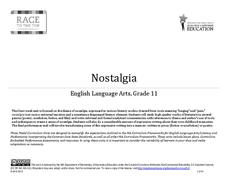Missouri Department of Elementary
Caution: Thin Ice!
Sixth graders listen to a story titled "Thin Ice!" then partake in a whole-class discussion asking and answering questions about what was read. Scholars brainstorm risky behaviors in preparation for a game of RISKO—a game similar to...
National Park Service
Lesson 3: Resistance
During the time of slavery, resistance was a way of life for the men and women held in bondage. Using music as evidence of their fight against oppression, learners explore how enslaved people fought back. Writing prompts round out the...
Novelinks
The Devil’s Arithmetic: Anticipation Guide
Do you need to learn about someone's past before you can understand that person's behavior? Use an anticipation guide to think about the literary themes of Jane Yolen's The Devil's Arithmetic before you begin the novel.
National Park Service
Lesson 4: Escape
Some enslaved people decided to run for their liberation. Using lyrics of songs they sang, young historians look at these anthems of freedom. An assessment asks them to write the story of escape from the perspective of an enslaved person.
Curated OER
Experience This!
What would you do if you had to go to school all day every day? Tillie tackles this problem in Sharon Creech’s A Fine, Fine School. After a discussion of how Tillie got the principal to change his ways, brainstorm with your class...
Curated OER
If I Were the Wind
Eighth graders are introduced to authors in the conservation community. As a class, they describe a personal experience they have had with nature. They identify examples of an author's descriptive writing techniques and answer questions...
Curated OER
Create a Holiday for Your Favorite Hero
Students create a holiday for a hero. The person may be someone in history who is not currently honored with a holiday, another famous person, a family member, a friend, or someone else they admire.
Curated OER
Beanie Baby Biographies
Learners write a biography for their favorite Beanie Babies and then share their biography out loud. A simple, yet effective idea! Everyone loves their Beanie Baby!
Starfall
This is Me
For this literacy learning exercise, students draw a picture of themselves and then compose a sentence that is descriptive of who they are.
Curated OER
I Heard It Through the Grapevine
Students write a first-person narrative from the perspective of a runaway slave, or a historical character of the period, and present their story orally.
Curated OER
Once Upon a Genre
Students examine fractured fairy tales before responding by writing in many different genres including a persuasive essay, a personal narrative, a letter, an advertisement, and a resume'. They create a pop-up book with their written...
Curated OER
Does a Picture Always Say a Thousand Words?
Students read and discuss "Enigmatic Portraits of Teen-Agers Free of All Context," then choose a photograph and write a first-person narrative from the perspective of the subject.
Curated OER
Self Portrait on Paper
Learners are guided into creating their own self-portrait in steps using colored pastels. They also use their self-portraits as a springboard to write a personal narrative. This is a cool lesson!
Curated OER
Guidebook
Students create a guidebook page about a plant on the school grounds. In this life and plant science lesson plan, students identify plants around the school, then research the plant and write a narrative about it. Students publish the...
Georgia Department of Education
Creating Suspense
Fifth graders practice creating suspense in writing. In this narrative lesson, 5th graders read stories that create suspense through the use of cliff- hangers. They use cliff-hangers in their own writing.
Curated OER
Persuasive Letters and The Tell Tale Heart
Pupils write persuasive letters based on "The Tell Tale Heart." They brainstorm topic sentences, main ideas, and details. They analyze the character and determine if he is innocent or guilty. They create a map listing their reasons to...
EngageNY
Writing Narratives from First Person Point of View: Imagining Meg Lowman’s Rainforest Journal
I spy with my little eye! Learners observe page 23 in The Most Beautiful Roof in the World and practice what they would add to a field journal. They discuss how details from the text help add to their thoughts. To finish, readers use...
Curated OER
The Final Word
Although this instructional activity is based on “Final Word,” Craig Wilson’s USA Today column, the strategies could be adapted to any local columnist. After reading three articles independently, groups share observations about content...
Massachusetts Department of Education
Nostalgia
To prepare for crafting their own memoir, class members examine poetry by Margaret Atwood, Billy Collins, Robert Hayden, and Claude McKay, stories by Richard Rodriquez and Willa Cather, and Barry Levinson's film Avalon. They examine how...
Calculated Industries
Army Survival
Intended as a reference tool for US Army personnel, this application can be used in a classroom that is studying historic and current wars or as part of an outdoor education or wilderness survival course. Some of the subjects addressed...
Crafting Freedom
George Moses Horton: Slavery from a Poet's Perspective
Pupils have the unique opportunity to learn about the institution of slavery by reading first-hand experiences as described by George Moses Horton, the first slave to publish anti-slavery poetry.
Curated OER
The Stories Behind the Masterpieces
Students examine Rembrandt's self-portraits and discuss important events in his life. They also examine "Aristotle with the Bust of Homer" and try to identify with the person in the paining, predicting what his life might have been like....
Curated OER
Country Comparison Venn Diagram
Fifth graders discuss different countries, their cultures, similarities and differences and choose a set of focus questions to research. They create a narrative story using their researched information in first person narrative stories.
Curated OER
Dear Diary
In this narrative learning exercise, learners compose a diary entry that includes different facets of writing. Students then respond to different narratives in the class by answering 11 different questions.

























